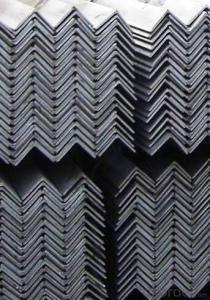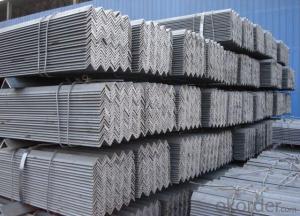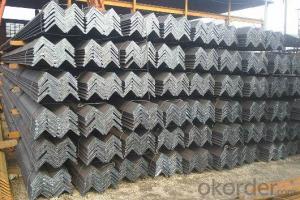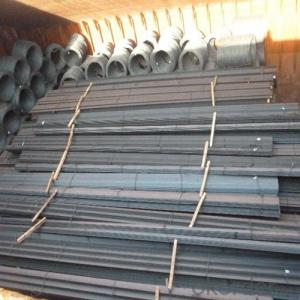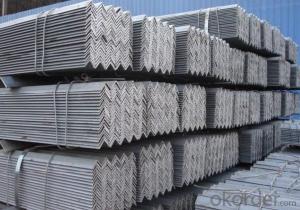Products Steel Angle Bar with High Quality
- Loading Port:
- Tianjin
- Payment Terms:
- TT or LC
- Min Order Qty:
- 25 m.t.
- Supply Capability:
- 20000 m.t./month
OKorder Service Pledge
OKorder Financial Service
You Might Also Like
Product Description:
OKorder is offering high quality Steel Angles at great prices with worldwide shipping. Our supplier is a world-class manufacturer of steel, with our products utilized the world over. OKorder annually supplies products to European, North American and Asian markets. We provide quotations within 24 hours of receiving an inquiry and guarantee competitive prices.
Product Applications:
Steel Angles are ideal for structural applications and are widely used in the construction of buildings and bridges, and the manufacturing, petrochemical, and transportation industries.
Product Advantages:
OKorder's Hot Rolled Steel Angles are durable, strong, and resist corrosion.
Main Product Features:
· Premium quality
· Prompt delivery & seaworthy packing (30 days after receiving deposit)
· Corrosion resistance
· Can be recycled and reused
· Mill test certification
· Professional Service
· Competitive pricing
Product Specifications:
Manufacture: Hot rolled
Grade: Q195 – 235
Certificates: ISO, SGS, BV, CIQ
Length: 6m – 12m, as per customer request
Packaging: Export packing, nude packing, bundled
Sizes: 25mm-250mm | ||
a*t | ||
25*2.5-4.0 | 70*6.0-9.0 | 130*9.0-15 |
30*2.5-6.6 | 75*6.0-9.0 | 140*10-14 |
36*3.0-5.0 | 80*5.0-10 | 150*10-20 |
38*2.3-6.0 | 90*7.0-10 | 160*10-16 |
40*3.0-5.0 | 100*6.0-12 | 175*12-15 |
45*4.0-6.0 | 110*8.0-10 | 180*12-18 |
50*4.0-6.0 | 120*6.0-15 | 200*14-25 |
60*4.0-8.0 | 125*8.0-14 | 250*25 |
FAQ:
Q1: Why buy Materials & Equipment from OKorder.com?
A1: All products offered byOKorder.com are carefully selected from China's most reliable manufacturing enterprises. Through its ISO certifications, OKorder.com adheres to the highest standards and a commitment to supply chain safety and customer satisfaction.
Q2: How do we guarantee the quality of our products?
A2: We have established an advanced quality management system which conducts strict quality tests at every step, from raw materials to the final product. At the same time, we provide extensive follow-up service assurances as required.
Q3: How soon can we receive the product after purchase?
A3: Within three days of placing an order, we will begin production. The specific shipping date is dependent upon international and government factors, but is typically 8 to 10 workdays.
Images:

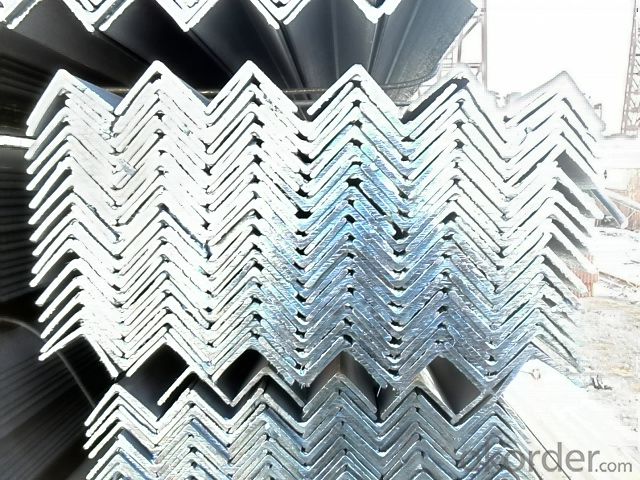

- Q: What are the different types of connections used for steel angles?
- There are several types of connections that can be used for steel angles, depending on the specific application and load requirements. Some common types of connections include: 1. Welded Connection: This is the most common type of connection used for steel angles. It involves welding the angle to the connected members, such as beams or columns. Welded connections provide high strength and stiffness, making them suitable for heavy loads and structural applications. 2. Bolted Connection: In this type of connection, steel angles are bolted to the connected members using bolts and nuts. Bolted connections are preferred when disassembly or relocation of the structure is anticipated. They offer flexibility in terms of adjustability and ease of installation. 3. Riveted Connection: Riveting involves joining the steel angle to the connected members using rivets. Although not as commonly used nowadays, riveted connections were widely used in older structures. They provide good strength and durability but require skilled labor for installation. 4. Clip Connection: A clip connection is a type of bolted connection where a clip or bracket is used to connect the steel angle to the supporting member. This allows for easy assembly and disassembly, making it suitable for temporary structures or situations requiring frequent modifications. 5. Shear Connection: In shear connections, the steel angle is connected to the supporting member using shear plates or angles. Shear connections are primarily used to transfer shear forces between members and provide sufficient strength and rigidity. 6. Cleat Connection: Cleat connections involve using a cleat plate, typically welded or bolted, to connect the steel angle to the supporting member. Cleat connections are commonly used in industrial applications where heavy loads and high forces need to be transferred. It is important to consider the specific requirements of the structure, such as load capacity, design codes, and environmental conditions, when selecting the appropriate type of connection for steel angles. Additionally, consulting with a structural engineer or referring to the relevant design standards can ensure the proper selection and installation of the connection.
- Q: How are steel angles installed?
- Steel angles are typically installed by first measuring and marking the desired location on the surface where they will be placed. Then, holes are drilled into the surface and anchors are inserted to provide stability. The steel angles are then positioned over the anchors and secured using bolts or screws. Care is taken to ensure that the angles are level and properly aligned before final tightening of the fasteners.
- Q: What are the design considerations when using steel angles?
- When using steel angles in design, there are several important considerations to keep in mind. First and foremost, the load-bearing capacity of the steel angles must be carefully evaluated. The size, thickness, and configuration of the angles should be chosen based on the anticipated loads and stresses that the structure will experience. Another consideration is the structural integrity of the connections between the steel angles and other elements of the design. The connections should be designed to ensure adequate strength and stiffness, as well as to accommodate any potential movement or deformation of the angles. It is also important to consider the potential for corrosion when using steel angles. Appropriate protective coatings or treatments should be applied to prevent rust and deterioration over time, particularly in outdoor or high-moisture environments. Aesthetics and visual appeal are also important design considerations. The shape, finish, and overall appearance of the steel angles should be chosen to align with the desired aesthetic of the project, whether it is a modern, industrial look or a more traditional and ornamental design. Finally, cost and availability should be taken into account when using steel angles. The cost of the materials, fabrication, and installation should be weighed against the overall budget for the project, and the availability of the desired sizes and configurations of steel angles should be considered to ensure a smooth and timely construction process. By carefully considering these design considerations, designers can effectively incorporate steel angles into their projects, ensuring structural integrity, aesthetic appeal, and cost-effectiveness.
- Q: What are the different types of steel angles connections for roof trusses?
- There are several different types of steel angle connections that are commonly used for roof trusses. These connections are designed to provide strong and stable support for the trusses, ensuring the structural integrity of the roof. One common type of steel angle connection is the gusset plate connection. This involves using steel plates, typically in a triangular shape, to connect the various members of the truss at their intersection points. The gusset plates are usually welded or bolted to the steel angles to create a secure connection. Another type of steel angle connection is the angle cleat connection. In this type of connection, steel angles are used to connect the truss members using bolts or welding. The angles are typically bolted or welded to the top and bottom chords of the truss, providing additional strength and stability. A third type of steel angle connection is the angle clip connection. This involves using steel clips or brackets to connect the truss members at their intersection points. The clips are typically bolted or welded to the steel angles, creating a strong and secure connection. Finally, there is the angle bracket connection. This type of connection involves using steel brackets or brackets to connect the truss members. The brackets are typically bolted or welded to the steel angles, providing a reliable and sturdy connection. Overall, there are various types of steel angle connections that can be used for roof trusses, each offering different advantages and characteristics. The specific type of connection used will depend on factors such as the design requirements, load-bearing capacity, and construction methods.
- Q: Can steel angles be used in the construction of hospitals?
- Steel angles are indeed suitable for use in the construction of hospitals. They are commonly employed in construction projects due to their ability to provide structural support and stability. When it comes to constructing hospitals, steel angles have a wide range of applications. They can be used for framing, support beams, trusses, and reinforcing walls and floors. Steel angles are renowned for their strength, durability, and fire resistance, which makes them ideal for meeting the demanding safety requirements of hospital buildings. Moreover, steel angles can be easily fabricated and manipulated to meet the specific design and structural needs of a hospital, allowing for flexibility in the construction process. All in all, steel angles are a dependable and versatile material that can be effectively utilized in hospital construction.
- Q: What does L50*4 angle mean in CAD?
- L50*4 in the steel structure is 50mm wide *50mm width *4mm thick equilateral angle iron, that is, the 50 series of angle steel.
- Q: What are the different types of steel angles used in architectural applications?
- There are several different types of steel angles that are commonly used in architectural applications. One type is the equal leg angle, also known as a L-shaped angle or L-bar. This type of angle has equal legs that form a 90-degree angle, making it suitable for various structural applications such as framing, bracing, and support. Another common type is the unequal leg angle, also known as a L-shaped angle or L-bar with unequal legs. This angle has one leg longer than the other, allowing for versatile applications where different lengths are required. It can be used for various architectural purposes such as edging, corner protection, and decorative accents. A third type of steel angle used in architectural applications is the bent angle. This angle is formed by bending a piece of flat steel to the desired angle. Bent angles are often used in architectural designs to create curved or unique-shaped structures, adding visual interest and enhancing aesthetics. Lastly, there is the perforated angle, which is an angle with holes punched along its length. This type of angle is commonly used in architectural applications where ventilation, drainage, or lightweight structural support is required. The perforations allow for airflow, water drainage, or the attachment of additional components. Overall, the different types of steel angles used in architectural applications provide architects and designers with a wide range of options to suit their specific project requirements, whether it be structural stability, aesthetic design, or functional purposes.
- Q: What is angle iron?
- The angle iron can be made up of different force components according to the different structure, and can also be used as the connecting piece between the components. Widely used in a variety of architectural and engineering structures, such as beams, bridges, towers, hoisting and conveying machinery, ships, industrial furnace, reaction tower, container rack and warehouse shelves, also used to protect column, wall parts easy to hit.
- Q: What are the different methods for joining steel angles?
- There exist various techniques for connecting steel angles, each possessing its own advantages and applications. Welding, bolting, and utilizing adhesive or epoxy are among the most frequently employed methods. Welding is a favored approach for joining steel angles due to its capacity to establish a sturdy and enduring connection. The process involves melting the edges of the angles using a welding torch, allowing them to cool and solidify, thereby creating a bond between the two pieces. Depending on the project's specific requirements, welding can be executed using diverse techniques such as arc welding, MIG welding, or TIG welding. Bolting is another commonly utilized method for joining steel angles, whereby nuts and bolts are employed to secure the angles together. This technique permits easy disassembly and reassembly, making it suitable for scenarios that demand flexibility. Additionally, bolting does not require any heat or special equipment, rendering it a relatively straightforward and cost-effective option. Utilizing adhesive or epoxy represents a non-traditional technique for connecting steel angles. This method involves the application of a potent adhesive or epoxy onto the contact surfaces of the angles, which are subsequently pressed together. Particularly when employing high-strength adhesives designed for metal bonding, this approach can yield a robust and long-lasting bond. Adhesive bonding is often employed in situations where welding or bolting may prove impractical or undesirable, such as when dealing with thin or delicate materials. Ultimately, the selection of a joining method for steel angles depends on various factors, including the specific application, desired strength and durability, ease of installation, and the necessity for disassembly or flexibility. Consulting with an expert or engineer is recommended to determine the most suitable joining method for a particular project.
- Q: Can steel angles be used in architectural or decorative applications?
- Yes, steel angles can be used in architectural or decorative applications. They are versatile and can be shaped and finished in various ways to create unique and aesthetically pleasing designs. Steel angles are commonly used for structural support, but they can also be utilized as decorative accents, such as in railings, door frames, or furniture.
Send your message to us
Products Steel Angle Bar with High Quality
- Loading Port:
- Tianjin
- Payment Terms:
- TT or LC
- Min Order Qty:
- 25 m.t.
- Supply Capability:
- 20000 m.t./month
OKorder Service Pledge
OKorder Financial Service
Similar products
Hot products
Hot Searches
Related keywords
